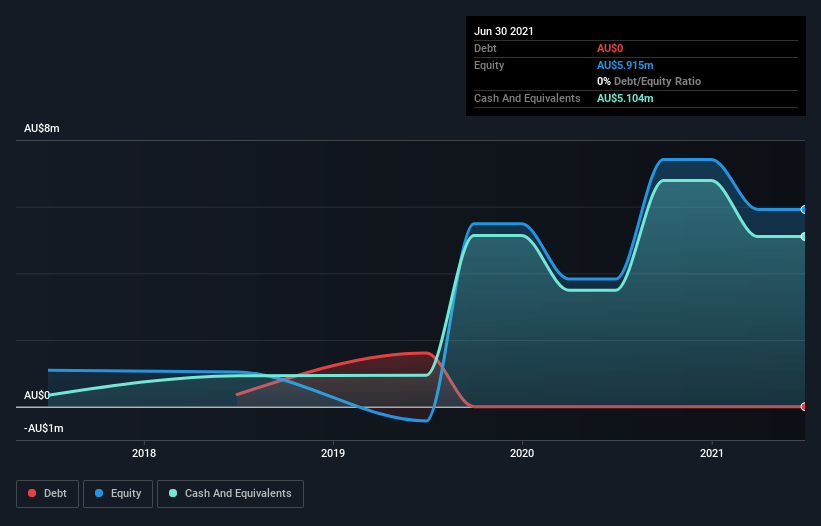We Think K-TIG (ASX:KTG) Can Afford To Drive Business Growth

Even when a business is losing money, it's possible for shareholders to make money if they buy a good business at the right price. For example, although software-as-a-service business Salesforce.com lost money for years while it grew recurring revenue, if you held shares since 2005, you'd have done very well indeed. But while history lauds those rare successes, those that fail are often forgotten; who remembers Pets.com?
So should K-TIG (ASX:KTG) shareholders be worried about its cash burn? In this report, we will consider the company's annual negative free cash flow, henceforth referring to it as the 'cash burn'. The first step is to compare its cash burn with its cash reserves, to give us its 'cash runway'.
See our latest analysis for K-TIG
When Might K-TIG Run Out Of Money?
A company's cash runway is the amount of time it would take to burn through its cash reserves at its current cash burn rate. When K-TIG last reported its balance sheet in June 2021, it had zero debt and cash worth AU$5.1m. Looking at the last year, the company burnt through AU$4.0m. So it had a cash runway of approximately 15 months from June 2021. That's not too bad, but it's fair to say the end of the cash runway is in sight, unless cash burn reduces drastically. The image below shows how its cash balance has been changing over the last few years.

How Is K-TIG's Cash Burn Changing Over Time?
In our view, K-TIG doesn't yet produce significant amounts of operating revenue, since it reported just AU$1.6m in the last twelve months. Therefore, for the purposes of this analysis we'll focus on how the cash burn is tracking. It seems likely that the business is content with its current spending, as the cash burn rate stayed steady over the last twelve months. Of course, we've only taken a quick look at the stock's growth metrics, here. You can take a look at how K-TIG is growing revenue over time by checking this visualization of past revenue growth.
How Hard Would It Be For K-TIG To Raise More Cash For Growth?
Since its cash burn is increasing (albeit only slightly), K-TIG shareholders should still be mindful of the possibility it will require more cash in the future. Companies can raise capital through either debt or equity. One of the main advantages held by publicly listed companies is that they can sell shares to investors to raise cash and fund growth. By comparing a company's annual cash burn to its total market capitalisation, we can estimate roughly how many shares it would have to issue in order to run the company for another year (at the same burn rate).
K-TIG's cash burn of AU$4.0m is about 7.3% of its AU$55m market capitalisation. That's a low proportion, so we figure the company would be able to raise more cash to fund growth, with a little dilution, or even to simply borrow some money.
How Risky Is K-TIG's Cash Burn Situation?
Even though its increasing cash burn makes us a little nervous, we are compelled to mention that we thought K-TIG's cash burn relative to its market cap was relatively promising. While we're the kind of investors who are always a bit concerned about the risks involved with cash burning companies, the metrics we have discussed in this article leave us relatively comfortable about K-TIG's situation. On another note, we conducted an in-depth investigation of the company, and identified 4 warning signs for K-TIG (1 is potentially serious!) that you should be aware of before investing here.
Of course K-TIG may not be the best stock to buy. So you may wish to see this free collection of companies boasting high return on equity, or this list of stocks that insiders are buying.
Valuation is complex, but we're here to simplify it.
Discover if K-TIG might be undervalued or overvalued with our detailed analysis, featuring fair value estimates, potential risks, dividends, insider trades, and its financial condition.
Access Free AnalysisThis article by Simply Wall St is general in nature. We provide commentary based on historical data and analyst forecasts only using an unbiased methodology and our articles are not intended to be financial advice. It does not constitute a recommendation to buy or sell any stock, and does not take account of your objectives, or your financial situation. We aim to bring you long-term focused analysis driven by fundamental data. Note that our analysis may not factor in the latest price-sensitive company announcements or qualitative material. Simply Wall St has no position in any stocks mentioned.
Have feedback on this article? Concerned about the content? Get in touch with us directly. Alternatively, email editorial-team (at) simplywallst.com.
About ASX:KTG
K-TIG
K-TIG Limited, a technology company, develops and manufactures welding technology in Australia, the United Kingdom, the United States, the Asia Pacific, and internationally.
Medium with adequate balance sheet.
Market Insights
Community Narratives




